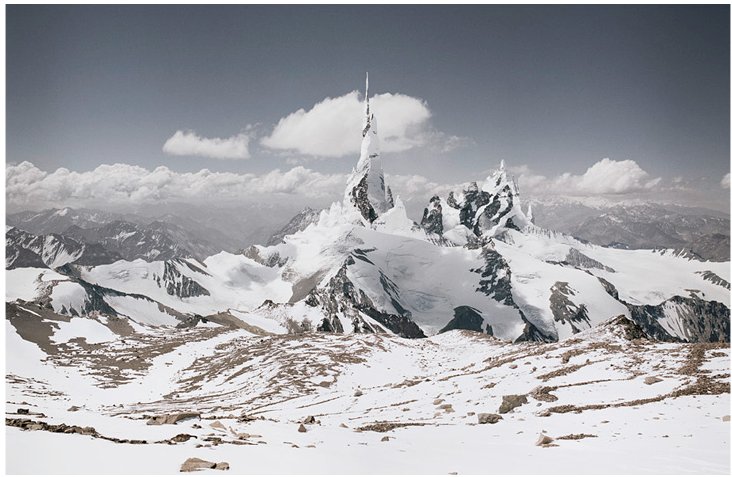
bitforms Gallery 529 west 20th street NY 10011 New York États-Unis
Berlin-based Michael Najjar returns to New York with a two-part exhibition at bitforms gallery and
in the new bitforms project room
September 18 – October 24, 2009
Michael Najjar debuts high altitude at bitforms gallery, 529 West 20th St, 2nd floor
Sublime panoramas and networked financial data co-exist inside a virtual landscape informed by the artist's recent expedition to Mount Aconcagua.
Reception: Friday, September 18, 6:00 PM – 8:30 PM
Gallery Hours: 11:00 AM to 6:00 PM, Tue–Sat
October 15 – November 7, 2009
Grand opening of the bitforms gallery project room, 529 West 20th St, 6th floor
Featuring Michael Najjar’s entire netropolis portfolio Transforming the real experiential city into closely woven grids of information, these twelve works
embody the space of networked exchange.
There is no real and no imaginary except at a certain distance. What happens when this distance, even the one separating the real from the imaginary, begins to disappear and to be absorbed by the model alone?
– Jean Baudrillard
bitforms gallery is pleased to announce a third solo exhibition with German photographic artist Michael Najjar and the world premiere of his high altitude work series. In this body of work, Najjar continues to weld fact and fiction. Exploring vocabulary of the romantic sublime, including paintings by Caspar David Friedrich, and informed by the artist’s own climb up to the 22,800 foot summit of Mount Aconcagua in Argentina, high altitude features breathtaking panoramas. Picturing spaces in society driven by networked financial data, these virtual landscapes are a meditation on the global market structure, its sophistication, and vulnerability.
The spectacle of elemental forces at play in mountainous vistas has been an enduring source of
fascination for people, and especially artists, across the ages. Relating a parable of risk and cataclysm, Michael Najjar’s nine large format photographs draw a visual comparison between the forces of nature and those in the modern economy driven by computer networks. Cliff and rock formations in these sweeping horizons portray development of the world’s leading stock exchange indices over the past 20 – 30 years. Like a graph or blueprint, Najjar suspends the performance charts of indices such as the Dow Jones, Hang Seng, Nikkei and Dax over the mountain peaks, and then alters the natural course of each mountain range. Pairing pure natural beauty with the development of the global financial system, a virtual value system is mapped.
“The current economic crisis has dramatically highlighted one thing in particular – that we now often
deal not with real goods and commodities but with chains of signifiers” says Michael Najjar. The
irrational – something which defies our powers of imagination – in turn shapes the reality of our daily lives. In this way a symbiosis is created between reality and virtuality. The expressive power of mountains and stock markets share certain aspects in common. Both have an emotional force; they can awaken feelings of happiness (reaching the summit, windfalls from speculation), yet they also carry components of risk within them (injuries, losses). Both have the power to destroy lives. This is most strikingly revealed in the work entitled “Lehman Brothers_92-08” which shows how the high degree of complexity in our present-day virtual world can lead to a total system crash. The shared course climbs and climbs, and ends abruptly – leaving only emptiness and the sloping mountain plateau behind.
Najjar’s works are also concerned with exploring the nature of the sublime, the ineffability of perception. According to Edmund Burke, sublimity is compounded delight and horror in equal measure. We may encounter feelings of the sublime in our everyday lives, in nature, or indeed in the financial world whenever the benchmarks by which we usually measure and gauge experience are invalidated or transcended.Such views and experience of sublimity are also reflected in the new works by Michael Najjar. The mountain has proven a consistent theme across the history of art, although not all artists have been interested in rendering an exact portrait. Caspar David Friedrich, for instance, painted the “Watzmann” peak without ever actually seeing it. His painting was not intended as a mere reproduction of nature but rather as a means of arousing feelings of awe and wonder “too deep for words”. It was scientific curiosity that drew Leonardo da Vinci to mountains, while Gerhard Richter painted them for the atmospheric conditions they offered, their unclear contours bathed in diffused light. The motifs chosen by Michael Najjar are mystically haunting moments with craggy cliff plateaus, fragile cloud formations, frozen snow-clad summits or crisp views of mountain ridges against an ice blue sky – yet always with the jagged lines of the mountain’s silhouette – amonument of stock market quotations, hewn in stone, rising majestically over the world.
The work series is based on the photographs Najjar shot during his three week expedition up Mount Aconcagua in the Argentinean Andes whose summit he reached in January 2009. At 22,800 feet, Aconcagua is the highest mountain in the world outside of the Himalayas. According to Najjar, “The reality of nature and the life rhythm of a mountain cannot be measured on any human scale and thus becomes a virtual experience. Such experience of virtuality can also be found on the international economic and financial markets where the staggeringly large sums of money circulating the globe in real time defy our powers of comprehension.”

